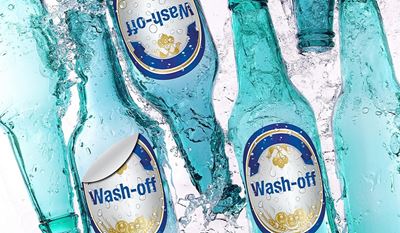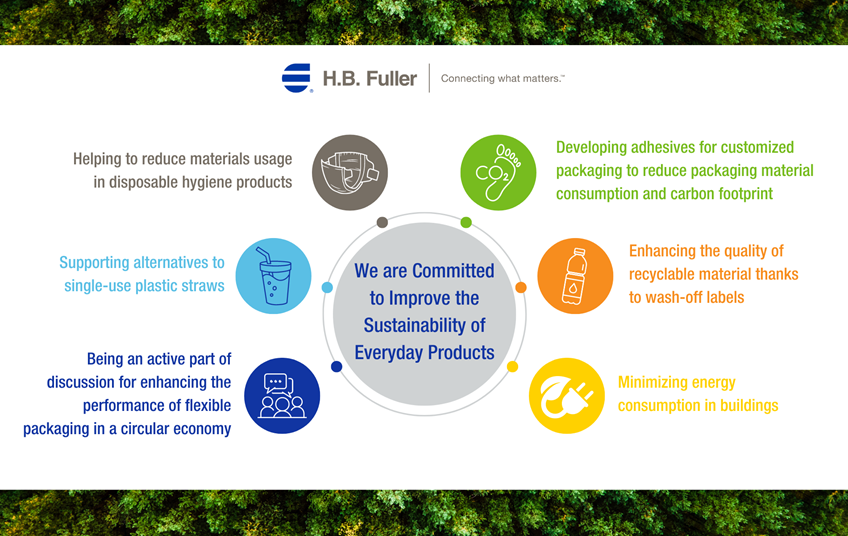
The Glue Talk Blog

 FEICA, the Association of the European Adhesive and Sealant Industry, and its members, including us, are committed to supporting the United Nations Sustainable Development Goals (UN SDGs). Innovation in manufacturing materials and processes can enable a circular economy, specifically in alignment with the Responsible Consumption and Production (12), and Climate Action (13) goals.
FEICA, the Association of the European Adhesive and Sealant Industry, and its members, including us, are committed to supporting the United Nations Sustainable Development Goals (UN SDGs). Innovation in manufacturing materials and processes can enable a circular economy, specifically in alignment with the Responsible Consumption and Production (12), and Climate Action (13) goals.
 FEICA is fully committed to foster sustainability and has appointed a Sustainability Steering Committee, encouraging its members to adopt business practices and develop innovative new products that support this priority. This resonated to us. Our adhesives enable manufacturers to work with more sustainable substrates, reduce materials usage, improve efficiencies, and reduce energy consumption, Greenhouse Gas (GHG) emissions and waste.
FEICA is fully committed to foster sustainability and has appointed a Sustainability Steering Committee, encouraging its members to adopt business practices and develop innovative new products that support this priority. This resonated to us. Our adhesives enable manufacturers to work with more sustainable substrates, reduce materials usage, improve efficiencies, and reduce energy consumption, Greenhouse Gas (GHG) emissions and waste.
Innovations in adhesive formulation and application support sustainability
“Reduce, reuse and recycle” are important ways to contribute to sustainability, mitigating the negative human impact on the environment. Here some case studies that illustrate how H.B. Fuller’s approach helps improve the sustainability of everyday products:
.jpg?h=390&w=400&hash=500FE7B85B0F7EA75182C19B1322367B) CEFLEX: enhancing the performance of flexible packaging in the circular economy
CEFLEX: enhancing the performance of flexible packaging in the circular economy
H.B. Fuller is a member of CEFLEX – the collaborative European consortium of companies and associations representing the flexible packaging industry value chain. CEFLEX aims to design and advance improved system solutions that should further enhance the performance of flexible packaging in a circular economy. Along with more than 130 other companies, we are participating in CEFLEX’s work to develop end markets for post-consumer recycled materials, demonstrate the business case for investment in collection and sorting systems, and promote flexible packaging design for improved circularity. Learn more: www.hbfuller.com/flexible-packaging
Helping to eliminate single-use plastic straws
Single-use plastic products are a major concern. In 2018, plastic straws were identified as a source of unsustainable levels of waste. According to a 2017 report from Seas at Risk, more than 36 billion plastic straws are used in Europe each year. Some companies, such as Starbucks and McDonald’s, pledged to phase out their use, and local, regional and national governments around the world have banned their use. Paper straws quickly emerged as an alternative, but to become a successful, long-term option, they will need to be strong, food safe, water resistant, hygienic, and biodegradable or compostable. And, they need to be commercially viable, meaning businesses and consumers are willing to pay a fair price, a reliable and efficient supply chain exists, and long-term usage rates emerge. H.B. Fuller’s technical specialists are working closely with customers to advise on the choice of paper and select the ideal adhesive from its range of solutions to efficiently manufacture sustainable alternatives to plastic straws. Learn more: www.hbfuller.com/ paper-converting
Reducing materials usage in hygiene products
There is an ongoing trend to manufacture hygiene products that feature thinner cores. In response, we have developed specialty hot melt adhesives that enable thinner and more comfortable disposable hygiene products that also perform well and minimize the environmental impact of disposable diapers, feminine care and incontinence products. Thinner cores require less material and energy to produce, so they require less shelf space, lower transportation costs and reduce landfill waste. Learn more: www.hbfuller.com/hygiene-solutions
.jpg?h=205&w=350&hash=626B2746A18A1277E90122F0F5CC7F70) "When conscious and responsible companies work together, they can make a positive change and protect the planet so future generations can walk confidently into their future.”
"When conscious and responsible companies work together, they can make a positive change and protect the planet so future generations can walk confidently into their future.”
Lynne Purvis, Hygiene Marketing Manager, EIMEA
Reducing packaging material consumption, carbon footprint, and transportation and manufacturing costs with customized packaging
Boosted by the global growth of e-retailing, millions of products are shipped to customers and businesses every day. Historically, shipping packages were available only in a range of standard sizes, and as a result, excessive packaging and cushioning material was often shipped along with the product, adding to manufacturers’ carbon footprint with higher freight and materials requirements. Today, automated, cut-to-size packaging lines are helping to reduce materials waste and optimize freight usage. This new type of end-of-line packing equipment evaluates the exact dimensions of each individual item to be packaged, and then cuts and flaps the box to create an ideal fit. However, while the boxes are right-sized to the product with packaging-on-demand, the board material is usually the same thickness.
H.B. Fuller developed the solution to this problem in the form of a unique adhesive-coated tape that can be laminated inside a corrugated substrate. This strengthens the package so that a thinner box or envelope performs like a heavy-duty package. The use of our specialty reinforcement, as well as our open and close tape systems, makes packages easier to open, and even to reclose so they can be reused to return products. Learn more: www.hbfuller.com/packaging-solutions
 Wash-off labels reduce material going to landfill and incineration
Wash-off labels reduce material going to landfill and incineration
With H.B. Fuller wash-off adhesives, the label comes off cleanly in the container recycling process so that no container needs to be dumped due to not being clean enough.They also reduce contamination and consumption of wash water as the adhesive remains attached to the label upon wash-off. Labels on containers, such as supermarket meat and fruit trays, also can be conveniently washed off with cold water, enabling the trays to be reused. Similar adhesives are available for a wide range of substrates, including glass and plastics.
Learn more: www.hbfuller.com/tapes-and-labels
Minimizing energy consumption in buildings
Insulating glass is what keeps the heat from coming in through your window in the summer and the cold out in the winter. Nearly every insulating glass unit is filled with inert gas between the panes. However, traditional aluminum spacer systems are not the most energy efficient solution.
Our KÖDISPACE 4SG warm-edge spacer system allows the gas to stay exactly where it should be – securely locked between the panes. KÖDISPACE 4SG is unique because it chemically bonds the materials on the edge of the panes and creates an elastic unit. The fusion of the components at the edge of your window panes guarantees absolute gas-tightness and long-lasting energy efficiency. Learn more: www.hbfuller.com/window
H.B. Fuller supports a circular economy in many ways
These are just some of the examples of how H.B. Fuller is applying its adhesives and process knowledge to help companies achieve their sustainability goals and support the circular economy. To learn more about the many ways H.B. Fuller focuses on sustainability read our Global Responsibility Report.

Blog Categories
Blog Categories
Archive
- 2024
- 2023
-
2022
- February (4)
- March (3)
- April (1)
- May (2)
- June (5)
-
August (6)
- Beverage Labeling Market In Africa: A Huge Potenial
- H.B. Fuller’s Glue House: Scavenger Hunt
- Increasing Global Aging Population: Impacts and Challenges
- Innovations and Key Challenges in Sustainable Disposable Absorbent Hygiene Products
- Supporting Racial Equity in Our Community
- Top 5 Reasons to Invest in H.B. Fuller
- September (4)
- November (2)
- December (2)
-
2021
- January (3)
-
February (7)
- Celebrating Exceptional Service During COVID-19 Complications
- Cyanoacrylates: What They Are and What They Do
- Innovative two-shot bookbinding adhesive
- Make a Difference 2020
- Problem Solving: Paper straws in drinking beverages
- Stronger straws
- Substances of Interest in Disposable Absorbent Hygiene Products
- March (4)
- April (4)
- May (4)
- June (5)
- July (2)
- August (5)
- September (2)
- October (1)
- November (3)
- December (2)
-
2020
- January (4)
- February (2)
- March (3)
- April (4)
- May (3)
-
June (7)
- Community Support in the Era of Coronavirus
- Employee Creates Face Shields with 3D Printer
- Improved Packaging Integrity and Greater Customer Satisfaction
- Liquid-Resistant Paper Straws
- What is a Sealant
- What Is the Future of Commercial Disinfectants
- Winning over consumers with e-commerce packaging solutions
-
July (6)
- Employees Take Action to be Part of Healing and Growth
- Gain a competitive advantage with packaging adhesive solutions
- HB Fuller Company Foundations Commitment to Communities
- Packaging Solutions for the South African Agriculture Market
- Supporting Organizations That Provide STEM Education for Youth
- Where Does Sustainability Stand Amid COVID-19
- August (3)
- September (2)
- October (4)
- November (2)
- December (4)
